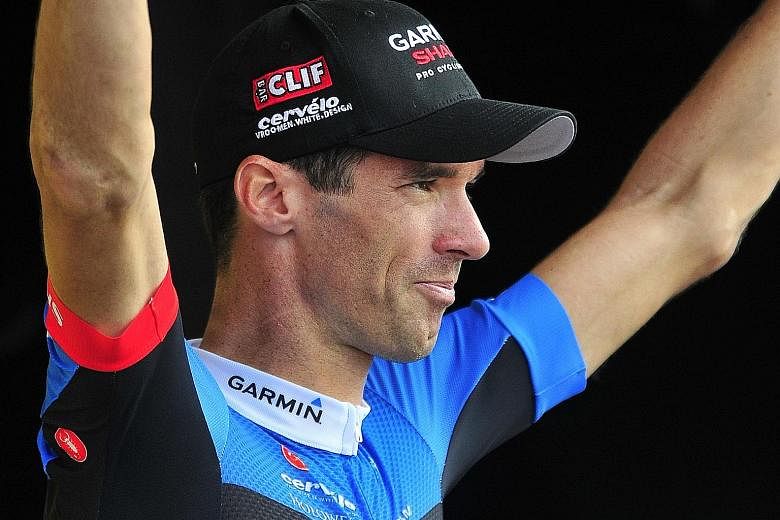LONDON • In 2004, I was in a French prison cell, arrested by a Paris drug squad. I had broken the law - as it turned out, not French law, but sporting law.
I had taken performance-enhancing drugs, and I had won some of the biggest races in the sport of cycling, including a world championship title. I had cheated.
In those days, those of us who were doping considered ourselves above the law. It was the reign of Lance Armstrong, and not only was he treated like a king, but he also acted like one.
The culture within cycling has changed enormously in the past 15 years: What was once a doping culture has become an anti-doping culture, and the biggest races are today being won by clean riders. And yet there has been an elephant in the room during this period of transition: the therapeutic use exemption (TUE) culture which has come to light via the leak of Olympic athletes' World Anti-Doping Agency (Wada) records by the anonymous hacker group known as Fancy Bears.
This is the official name for an athlete's right to use a banned substance - under medical supervision and with a doctor's approval.
But as the Fancy Bears hack shows, the practice of obtaining TUEs - ostensibly to treat disorders like asthma and allergies - is common among world-class athletes.
It is possible that all the TUEs revealed in the Wada leak were for legitimate medical reasons, but the system is open to abuse.
Some of the medical conditions used to justify a TUE can be difficult to validate; and as I discovered, an unscrupulous rider and doctor could exaggerate or simply make up symptoms that would merit a prescription and exemption.
I turned professional in 1997 and came face to face with the dark truth that professional cycling had a deeply embedded doping culture.
I was told early on that it would be impossible to win the Tour de France clean, that this was a commonly known fact within the peloton.
By the 2001 season, I was taking the banned blood-boosting agent erythropoietin, or EPO, and testosterone in secret training camps before my target races; then, on three occasions, I took cortisone.
I would make sure the performance-enhancing drugs were used only in training phases where I could be sure I would not be tested (this was before the athlete whereabouts system existed, so there was no out-of-competition testing). By the time I got to the races, my body was clean, although it carried the benefits of the drugs.
Once I hit my target levels and felt ready for the big push, a doctor would administer the cortisone via an intramuscular injection.
First to go would be the excess fat I hadn't been able to rid myself of, no matter how strict my diet. Then I would start to feel different: My sleep would become restless, yet in the mornings I'd feel more alert than ever. I'd begin to feel physically stronger, able to do things on the bike previously impossible. For me, this would mean being able to push bigger gears, which is the equivalent of lifting heavier weights. The effect was so powerful that the tendons in my knees and ankles would ache from the increased force they were dealing with.
The body's natural reaction to such overloading is inflammation, but after the cortisone injection, the puffiness I'd normally see in my body disappeared.
One drug in particular that is available with a TUE has come to light in the Fancy Bears leak: triamcinolone acetonide, more commonly known by its brand names, Kenalog and Kenacort.
This is a very powerful synthetic corticosteroid. I know this because I've used it, three times, including once when I received a TUE for a fake tendon issue.
I took it (Kenacort) only twice after 2001: for the 2002 Tour of Spain and the 2003 Tour de France. Both were big targets, as, for the first time, I was aiming for a high placing in the overall classification.
The three times I took Kenacort were also the times I was the lightest I'd been in my career, yet I didn't lose power - often the penalty when a rider sheds weight. It made me better all around, yet the benefits were outweighed by the negatives. The cortisone made me too edgy. It altered my mental state, my insomnia got worse and mood swings became more pronounced.
Ironically, neither race went particularly well.
I was taking this powerful, potentially dangerous drug as a performance enhancer, yet I was doing so within the rules - thanks to the TUE loophole.
Wada and the international governing body of cycling, the UCI, have failed in their oversight of the list of drugs available with a TUE and in their administration of the application process.
I served a two-year ban (after admitting to doping offences). My life was in ruins, but I felt relieved - at least I was free of all the deception and disgust.
In 1996, I believed myself incapable of cheating. My story illustrates only too well that none of us can be trusted to always do what is right. When the stakes are high, some will see it as sheer folly not to use every advantage available: Never mind if it's unethical, as long as it's not illegal. Just like our wider society, the sporting world needs effective laws and enforcement.
NYTIMES

